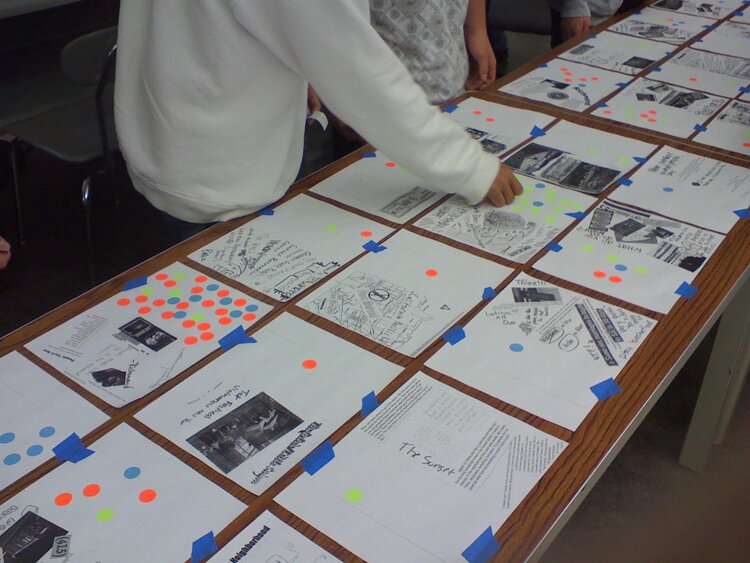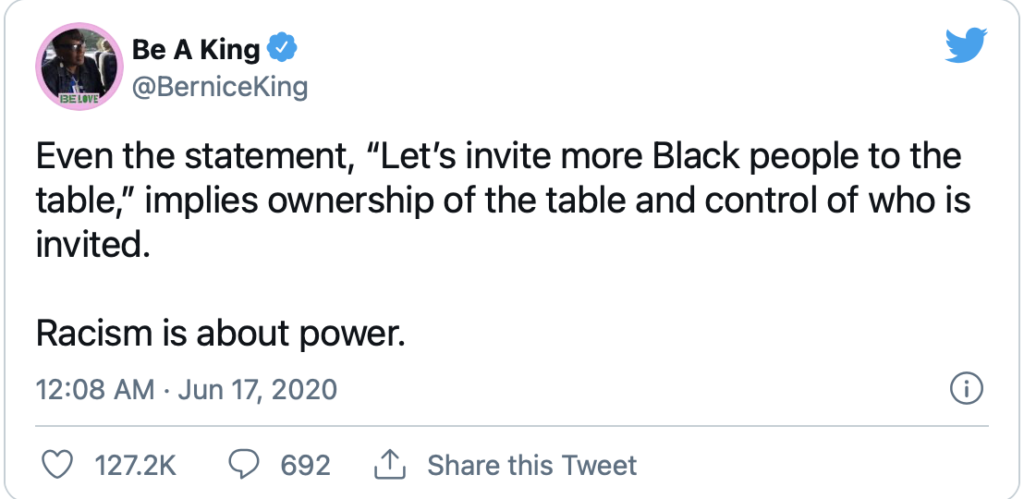Opinion: We Don’t Need More “Invitations to the Table.” We Need a New Table.

Photo: Wikimedia Commons
by Charles Marohn
This article from Strong Towns by Charles Marohn was originally published in June 2020 and is reposted here under Creative Commons license (CC-Sharealike 3.0).
Two years ago, I wrote about how most public engagement is worthless. I am not a fan of the ways we have oriented local government vertically, to essentially be an implementation arm of state and federal policy instead of servants of urgent local needs. While we’ve done this internally within local government, we’ve evolved our public engagement process for similar objectives.
You can think of local public engagement as peaceful pre-crowd control. How do we provide enough opportunity for feedback and engagement so that we can say that everyone was heard, but not so much that it actually refocuses our priorities from those that we hold internally? From my 2018 column:
I’m a planner and I’m a policy nerd. I had all the training in how to hold a public meeting and solicit feedback through SWOT (strengths, weaknesses, opportunities, threats) questions. I’ve been taught how to reach out to marginalized groups and make sure they too have a voice in the process. That is, so long as that voice fit into the paradigm of a planner and a policy nerd. Or so long as I could make it fit.
There has been a lot of conversation about this here at Strong Towns since that article, and the follow up by Rueben Anderson (“Most Public Engagement is Worse than Worthless”), were published. Common approaches to public engagement are broken because the objectives of that engagement are wrong.
A tweet by Bernice King succinctly summarizes the power dynamic at play.

I recognize the moment we are in and am not wanting to take away from it, but I would build off the core insights of that tweet by expanding it in the way Chris Arnade has described the “front row” and “back row” Americas. A year ago, Arnade wrote about those who own the table and control who is invited:
Our isolation from the bulk of the country left us with a narrow view of the world. We valued what we could measure, and that meant material wealth. Things that couldn’t be measured—community, dignity, faith, happiness—were largely ignored because they were hard to see, especially from so far away.
We had compassion for those who got left behind, but thought that our job was to provide them an opportunity (no matter how small) to get where we were. It didn’t occur to us that what we valued wasn’t what everyone else wanted. They were the people who couldn’t or didn’t want to leave their town or their family to get an education at an elite college, the people who cared more about their faith than about science. If we were the front row, they were the back row.
The front row owns the table. Through their actions, systems, and processes—through the questions they ask and the ground on which dialogue occurs—they generally decide who is invited to the table. I’m going to agree with Bernice King that there is a strong correlation with race in that, but clearly this is an experience shared throughout the entire back row.
We can get a glimpse of it from the front row. Recently, my colleagues and I were having a Slack chat about public engagement surveys. I’m going to leave my colleagues anonymous in sharing this dialogue.
Colleague 1: Our city is building a new police building/city hall, and they sent out a Survey Monkey asking for public comment on different design options, features, layouts, and more. It’s going to be the first thing people see as they enter our historic downtown area…and all the designs are sprawling, modern, with an aesthetic shelf-life of about five minutes, and look expensive to maintain. My written responses to the survey probably came across as curmudgeonly.
Colleague 2: [My spouse] and I are the same way. When our town hands out surveys, [spouse] actually fills it out multiple times bc we know that we’re the only people who are saying “less parking.’
Me: The school district did a number of similar things here when they were preparing their $200m+ bond issue. I would give very specific comments on design, layout, and aesthetics knowing that they were just going to laugh at it. It was really frustrating.
Colleague 2: We just had one about new wayfinding signs that our town is getting. It was a series of sign designs asking “which do you like best and why”?
We have this frustration and we know and understand the process. We have the luxury of having the time and capacity to engage. Given our anger at how things routinely transpire, it’s not difficult to appreciate the incredible degree of frustration experienced by those without our level of access.
The table metaphor is a powerful one in Christian religious practice. An “invitation to the table” is an act of service, one with no preconditions. It’s a practice that humbly accepts people where they are and demands nothing in return for that fellowship. It is at the most famous gathering at a table that Jesus, in the Gospel of John, tells his followers, “As I have loved you, so you must love one another.” He had just finished washing all of their feet, including those of the man who would hand him over to the authorities.
It’s not enough to merely send out more invitations to the existing table. If we’re prepared to truly be humble servants, if we’re ready to reorient our local governments away from the hierarchy of governments and towards the urgent needs of people within our communities, we actually have to redefine the table.
The table is not a physical object sitting in some meeting room at city hall. It’s not a visioning session, public hearing, or an online form. The table is out there. It’s the streets people are struggling to walk. It’s the dangerous crossing they are forced to make daily. It’s the substandard house they occupy or the small business they are trying to start. The table is our community.
And we are called to engage with it, not in ways that are comfortable to us, but in a manner that exposes us to the urgent needs of our neighbors. This is the Strong Towns Approach to Public Investment:
- Humbly observe where people struggle
- Identify the next smallest thing we can do to address that struggle
- Do that thing right away
- Repeat
It’s not “them” that need to receive our invitation. It’s we that need to recognize the invitation that’s been sent to us.
Charles Marohn is the founder and president of Strong Towns. He is a professional engineer and a land use planner with decades of experience. He holds a bachelor’s degree in civil engineering and a Master of Urban and Regional Planning, both from the University of Minnesota. Marohn is the author of Strong Towns: A Bottom-Up Revolution to Rebuild American Prosperity(Wiley, 2019). He hosts the Strong Towns Podcast and is a primary writer for Strong Towns’ web content. He has presented Strong Towns concepts in hundreds of cities and towns across North America. Planetizen named him one of the 10 Most Influential Urbanists of all time.

Amherst and I’m sure other towns have Objectives assigned to individuals working for the Town. It’s very common for Town manger and others to have an objective that they are reviewed upon that states that they will increase the Tax Base and Revenue. That the costs to the Town exceed the additional tax revenue is not a consideration. Amherst has a break even tax per household of more then $7,000.00 per family.
We have built in incentive to the Town manger and other department heads to coddle development and developers. This is regardless of the intelligence of such a decision. We keep on adding Low income projects that Keep the Poor poor and make a few rich at a detrimental expense too the entire entire Town. This expense is degrading all the Town services; despite the Highest Tax rate in western Mass.
We have normalized out schools so we have 30% to 40% low income across the Board vs 0ver 60% in some before redistricting. Good kids pick up bad behaviors easier then Bad Kids pick up good behaviors. This has destroyed the reputation/ranking of the Amherst Public school system; more than double the cost of Hadley per student. School system seems to think throwing more money at it will solve the issues that come with large numbers of low income Kids. Obviously it hasn’t worked so far; how long are we going to continue to fund, double student cost for poorer performance, that we have put in place.
Stop grading/reviewing department heads based on a Tax revenue increase without considering costs to the Town. If we did this most of what was considered good development would be considered BAD. Maybe the Town administration would start following and enforce TOWN’s zoning as is.
I’ve taught preschool through high school with the majority of my teaching career at the now closed Mark’s Meadow Elementary School. We teachers did not categorize students by “GOOD AND BAD” or even “good and bad.” We strived to learn about each student so that we could teach to their strengths and nurture their less developed skills whether academic, social or behavioral.
As to the cost of educating the average student compared to Hadley, Amherst provides more extensive academic and arts offerings as well as more sophisticated special education and English Second Language services in order to the meet the needs of all students regardless of economic and racial background. This is what Amherst parents want and expect. Each child in Amherst deserves a quality education.